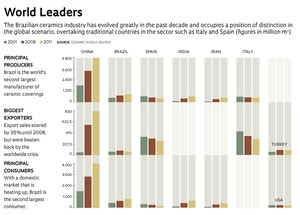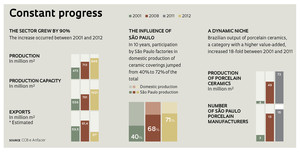Published in March 2013
 Infographics Ana Paula Campos
Infographics Ana Paula Campos
When the ConSITec project began in 2001, Brazil ranked fourth among the world’s producers of ceramic tiles, with production of 473 million m2. São Paulo represented 40% of the total production. Today, that state’s companies account for approximately 70% of the nation’s output of 866 million m2, and Brazil ranks second in the world. “When the companies began to coordinate in forming the consortium, the image of Santa Gertrudes products was quite negative. Items were seen as being of poor technical and esthetic quality,” recalls materials engineer José Octavio Armani Paschoal, president of the CCB and coordinator of the ConSITec project. “Now that’s changed. São Paulo has attained a position of distinction in terms of the manufacture of ceramic plates used for coverings. While once we trailed behind, now we’re on the front line,” he says.
 Infographics Ana Paula Campos
Infographics Ana Paula Campos
One of the principal benefits of the ConSITec project, which involved the investment of R$586,000 by FAPESP and an equal amount from the companies over a seven-year period, was a significant improvement in the quality of São Paulo ceramics. “The percentage of tiles rated Class A and free of defects such as cracks, scratches, stains, and variations in enamel hue, rose from 50% to 98% by the end of the program. Fewer than 2% of the ceramic tiles produced in this state today exhibit any imperfections,” says Paschoal. According to him, the first obstacle to overcome was to modify the production process employed at the factories in order to introduce a quality control system. “We realized that companies did not have control over the process as a whole. As soon as the CCB began quality certification of the finished products, the index of non-conformity with domestic and international standards fell drastically. The ceramic coverings industry became one of the leaders in the construction industry in terms of conformity with technical standards,” Paschoal reports. The number of companies in the ceramics industrial complex in Santa Gertrudes that turned out quality-certified products reached 20 in 2008, double the figure for the seven previous years. During the same period, the number of factories that had adopted the ISO 9001 quality certification system rose from 4 to 13.
In addition to achieving an increase in quality and number of certified products, São Paulo factories also began to make a higher volume of porcelain pieces. “Porcelain is a more expensive product and competes with natural stone, such as marble and granite,” says materials engineer Ana Paula Menegazzo, superintendent of the CCB. “When Brazilian companies began to make that type of product, customers with higher purchasing power bought the ‘brand’ and even paid more for it.” According to CCB figures, Brazilian production of porcelain tiles increased 18-fold during the past decade, soaring from four million cubic meters in 2001 to 72 million in 2011. During the same period, the number of São Paulo manufacturers of these goods rose from three, which had been producing only the small-size (mosaic) tiles, to 15 that now had sufficient know-how to make tiles larger than one square meter. Despite the increase in São Paulo, the biggest porcelain production center is still Santa Catarina—a state that also boasts a concentration of factories in an important ceramics industrial complex.
In inland São Paulo, Villagres, which is based in Santa Gertrudes, is one of the leading manufacturers of porcelain wall and floor tiles. With a tradition in ceramics production that goes back almost 90 years, it offers 108 different items in its portfolio and has been investing in new technologies. Villagres was one of the first in the state to use digital printing technology, an ink-jet process that makes it possible to use serigraphy on any ceramic surface. “It’s a sophisticated method, but, at the same time, easy to work on. You can, for example, scan a stone in its natural environment and reproduce its traits on porcelain. The machine functions as if it were a paper printer, the only difference being that it applies enamel to a ceramic tile,” explains Vanderli Vitório Della Coletta, owner of Villagres. The company produced 6 million m2 of ceramic coverings in 2012 and experienced a 6% growth in sales over 2011. “We had a very good year, and we are still expanding. We are improving our portfolio and migrating our production toward porcelain tiles,” he says.

Production line at Rochaforte: technology and improvements in manufacturing processes have yielded good resultsLÉO RAMOS
To Marcos Serafim, Manager of Innovation at CCB, digital printing introduces a new way of thinking about product design and the industrial methods employed in the sector. It also poses some challenges. “Despite all the technological changes, the most comprehensive transformation has to occur in design. The question now is how to capture, work up, and digitally manipulate those designs without bringing about graphic pasteurization,” he says. On that point, according to Serafim, Brazilian factories are still using as reference countries such as Spain and Italy, which market their digital designs either directly to Brazilian companies or through raw materials suppliers or design studios. “Brazil needs to innovate by creating its own identity in terms of product design,” he notes.
One determining factor in the growth of the ceramics industry in São Paulo is the quality of the raw materials used in manufacturing its products. “Santa Gertrudes has one of the best clay deposits in the world,” says Elson Longo, professor at the Chemistry Institute of the Universidade Estadual Paulista (Unesp) in Araraquara and Coordinator of the Multidisciplinary Center for the Development of Ceramic Materials (CMDMC), one of the 11 FAPESP Research, Innovation and Dissemination Centers (RIDC). “Furthermore, the red clay that is found close to the surface in that region is of excellent quality. This means that manufacturers need to use almost no additives to make their products. It’s an important competitive advantage,” Longo says. He coordinated the research under the ConSITec project on the academic side with researchers from the Federal University of São Carlos (UFSCar) and the Nuclear and Energy Research Institute (Ipen) of São Paulo. “The technology and know-how generated during the ConSITec project were possible only because of financing from FAPESP,” Longo says.
Because of the raw material’s properties, ceramic coverings made in inland São Paulo use dry milling, a simpler process than wet milling and one that reduces costs by as much as 50%. Preparation of a batch for wet milling, as performed in Santa Catarina and other places in Brazil, involves several steps. However, in the dry process, the clay passes through only one mill before it is ready for pressing. “The clay found in the Corumbataí formation in the Santa Gertrudes region has unusually good plasticity, which permits a shorter firing time, thus boosting productivity,” says Menegazzo.
The doctoral studies being pursued by materials engineer Rogers Rocha, owner of the Rochaforte factory in Cordeirópolis, focus on the properties of the clay found in the inland areas of São Paulo. “There is a huge difference between the clay found in one mine and that of another. I am researching the mineralogical, chemical and ceramic characteristics of the rocks in the Corumbataí formation from which the local factories get their clay,” states the researcher/businessman. “Better understanding the characteristics of the raw material will help us improve the quality of the items we produce.” Rochaforte was founded 60 years ago by Rocha’s grandfather. Like so many other companies in the industry in that region, it began by making roof tiles and bricks and progressed to offering flagstones, a type of rudimentary flooring. It now makes two million m2 a month of ceramic wall and floor tiles, using dry milling. “Nothing compares to that process in terms of cost,” states Rocha.
According to Rocha, the technological development and refinement of manufacturing processes were vital to the boom in São Paulo ceramics. “As our industry entered into closer contact with academia, the products and processes improved greatly. I’ve seen practical results from the research at my company. Some of our products are attaining the same level of quality as those made in Spain and Italy,” he says. In addition to selling to the domestic market, Rochaforte exports to customers in the U.S., Chile, Argentina, and some Central American countries.
Established 20 years ago, the CCB has played a key role in the evolution of Brazil’s ceramics industry. The center has conducted research and development on ceramic products, operating primarily in the context of the university/company interface and providing technical and technological consulting services to the industry. The Center for Technological Innovation in Ceramics (Citec/CCB) has a modern laboratory infrastructure that has been accredited by the National Institute of Metrology, Quality, and Technology (Inmetro) to conduct certification and quality control tests on products and processes. Citec has a fully equipped facility for making any type of ceramic tile on a laboratory scale, as well as equipment to assess mechanical strength, surface abrasion resistance, and the slip resistance of floor tiles.
In 2011 alone, 20,577 tests were performed at Citec/CCB laboratories, which are staffed by 12 researchers, of whom three have master’s degrees and three have doctoral degrees. “With the start of Citec operations, we began to develop new products, improve production methods, and engage in post-sale activities. That gave us a solid understanding of the principal problems that customers experienced with ceramic coverings. Similarly, we conducted research into methods of ceramic tile application, which enabled us to achieve a significant decline in problems encountered in laying the product,” Paschoal says.
 Infographics Ana Paula Campos
Infographics Ana Paula Campos
The favorable results of recent years have kept optimism high among manufacturers. Many São Paulo companies plan to expand their factories. Rochaforte, for example, is planning to open affiliates in the Northeast of Brazil. Those branches are important because the cost of shipping goods from the factories to the customer is an important factor in final product price. The expansion observed in the domestic market, according to Paschoal, is likely to continue heating up demand for ceramic wall and floor tile. “Despite the significant increase in construction of new housing in recent years, Brazil still has a large housing deficit—on the order of 10 million units. Furthermore, there is also the building renovation market, which suggests a major rise in potential consumption of ceramics,” he says. To Paschoal, the major challenge from here out is to increase the productivity of the Brazilian ceramics industry and encourage the development of new ceramic products, primarily through technological innovation, “enabling Brazil to achieve even more prominence in the world market.”
Project
Sector consortium of the ceramic coverings industry in the state of São Paulo: technological innovation and competitiveness (No. 2001/10783-5); Grant mechanism Sectoral Consortia for Research and Innovation (ConSITec); Coordinator José Octávio Armani Paschoal – CCB; Investment R$586,715.13 (FAPESP) and R$586,715.13 (Companies).